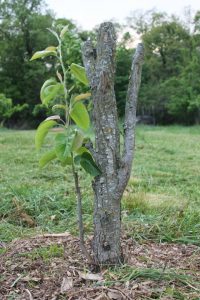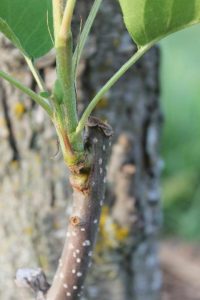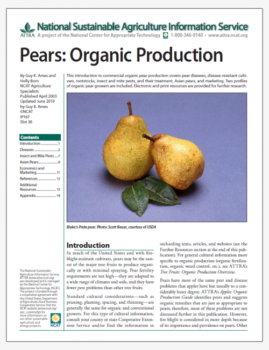Pears: Organic Production
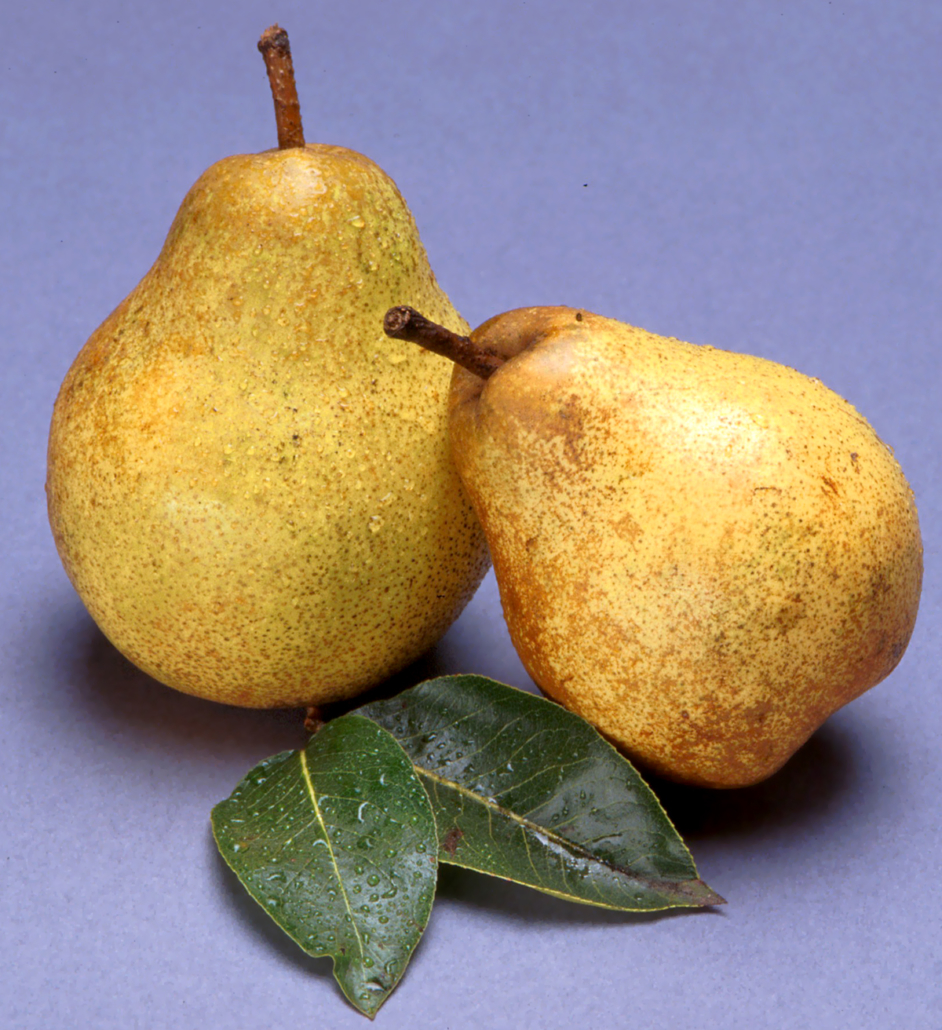
By Guy K. Ames and Holly Born, NCAT Agriculture Specialists
Abstract
This introduction to commercial organic pear production covers pear diseases, disease-resistant cultivars, rootstocks, insect and mite pests and their treatment, Asian pears, and marketing. Two profiles of organic pear growers are included. Electronic and print resources are provided for further research.
Introduction
In much of the United States and with fire-blight-resistant cultivars, pears may be the easiest of the major tree fruits to produce organically or with minimal spraying. Pears’ fertility requirements are not high, they are adapted to a wide range of climates and soils, and they have fewer pest problems than other tree fruits.
Standard cultural considerations—such as pruning, planting, spacing, and thinning—are generally the same for organic and conventional growers. For this type of cultural information, consult your county or state Cooperative Extension Service and/or find the information in orcharding texts, articles, and websites (see the Further Resources section at the end of this publication). For general cultural information more specific to organic production (organic fertilization, organic weed control, etc.) see ATTRA’s Tree Fruits: Organic Production Overview.
Pears have most of the same pest and disease problems that apples have, but usually to a considerably lesser degree. ATTRA’s Apples: Organic Production Guide identifies pests and suggests organic remedies that are just as appropriate to pears; therefore, most of these problems are not discussed further in this publication. However, fire blight is considered in more depth because of its importance and prevalence on pears. Other pests and diseases peculiar to or especially troublesome to pears are also discussed.
In the last two to three decades, another type of pear, the Asian pear, has joined the more familiar European pears in American orchards and in the American marketplace.
Diseases
Fire Blight
Fire blight, caused by the bacterium Erwinia amylovora, is the most serious and economically damaging disease of pears. Occurring throughout the pear’s range, it is particularly troublesome in the humid eastern United States. Infection is triggered by heat and moisture, and can spread rapidly—even within a matter of hours. It can be transmitted by bees, aphids, psylla, or other insects, and can also be spread by blowing wind and rain. Pruning can be another source of infection. Affected branches wither and turn black or brownish black, as if scorched (Figure 1).
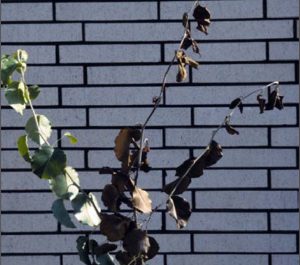
Figure 1. Characteristic fire blight symptoms on shoots and leaves. Photo: Florida Division of Plant Industry Archive, Florida Department of Agriculture and Consumer Services
Most branch tips, once infected, wilt rapidly, taking on the characteristic shape of a shepherd’s crook. The bacteria gain entry to the tree through blossoms or lush new growth and, once inside, begin to work toward the roots. If the disease spreads unchecked to the trunk and roots, it can kill the tree. Under the bark, the bacteria form a canker where they will survive the winter and infect more trees the next year.
Fire blight development is greatly favored by the presence of young, succulent tissues, and therefore cultural practices that favor only moderate growth of trees are recommended. These include using only half as much compost as for apples, never using fresh manure, and avoiding heavy populations of clovers and other legumes around the base of the tree. Likewise, heavy pruning can promote lush, vigorous growth, so such pruning should be avoided.
Choosing fire-blight-resistant pear cultivars is a good start to managing fire blight, but it is by no means a panacea (see the Appendix, “Fire Blight, Disease Resistance, and the Disease Triangle”). Relative resistance to the disease is sometimes informally measured by the extent of visible infection to the age of wood. For instance, Kieffer is commonly referred to as resistant because the disease rarely proceeds beyond one-year-old wood; you might see a lot of blight on Kieffer in a bad infection year, but rarely will such infection move beyond young wood and threaten the tree’s life. A highly-resistant cultivar, like Korean Giant, might show a few blighted blossoms, but it rarely suffers infection past that point (see Figure 2). Conversely, a highly susceptible cultivar like Bartlett, under disease-conducive conditions, could incur an infection that could run from new growth to roots and kill a mature tree in a single year.
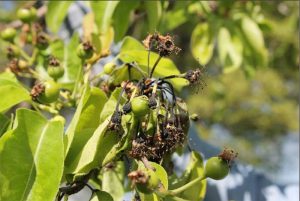
Figure 2. Blossom blight phase of fire blight on Koyama, a cultivar rated as “resistant” because the blight will generally not progress past the blossoms into older wood. Photo: Guy Ames, NCAT
There are several European-type pears with a comparatively high level of fire blight resistance (including Ayres, Blake’s Pride, Harvest Queen, Honeysweet, Magness, Maxine, Moonglow, Potomac, and Warren) that are adapted to most of the contiguous United States. Clapps, Bartlett, Comice, Anjou, Bosc, and most other cultivars that are not expressly described as “fire blight resistant” in a nursery catalog should be considered susceptible and grown organically only in the semi-arid production areas of the West; even then they will probably require protection (see below).
Asian-pear cultivars also vary in their resistance to fire blight. Shinko has a high level of resistance, while Korean Giant, Ya Li, Niitaka, Clear Moon, Shinsei, and Seuri are among the moderately resistant varieties. Shinseiki has been rated as “resistant” by Kentucky researchers and “susceptible” by Alabama A&M researchers (Jones and Fackler, 1995). Shin Li is listed as resistant in some literature, but experience with heavy fire blight pressure under humid Arkansas conditions indicates that it is quite susceptible. These variations in resistance ratings can usually be explained by differences among the growing sites, e.g., conditions in Arkansas are much more conducive to fire blight development than they are in New England or Oregon. It may be some time before all Asian-pear cultivars, being relatively new in the United States, are well classified in terms of blight resistance.
Preventing infection is the next key to fire blight control. Sprays of agricultural-grade antibiotics, applied at early bloom to prevent infection, have been the standard commercial control since the 1950s, but they are scheduled to be phased out for certified organic use in 2014 due to concerns about the buildup of antibiotic-resistant strains of bacteria. University researchers and the pear and apple industries have been working to find viable substitutes for these antibiotics, and their diligence is paying off with the development of several biocontrol products.
In general, these biocontrols work similarly to one another. They are non-pathogenic competitors with E. amylovora, and as such do not directly kill propagules of E. amylovora; rather, they occupy the same sites that E. amylovora would, provided they get there first. Therefore, in order to be effective, these should be applied to newly opening flowers (multiple applications will probably be necessary). Since they do not directly challenge the metabolism of E. amylovora, there is little risk of the pathogen building resistance to them.
Currently, according to Oregon State research (Johnson 2012), the best control seems to be the yeast Aureobasidium pullulans, packaged and sold as Blossom Protect™, a product of Westbridge Agricultural Products. Over a four-year period, Dr. Ken Johnson compared Blossom Protect to BlightBan™ (Pseudomonas flourescens, see below) and Bloomtime Biological™ (Pantoea agglomerans), and found Blossom Protect the best of the three biologicals; it provided “very good” protection from fire blight when properly applied (follow label directions). Blossom Protect has already received approval for use on certified organic farms by the Washington State Department of Agriculture, and Westbridge Agricultural Products is seeking approval from the Organic Materials Review Institute (OMRI). Visit the OMRI website for the current status.
Combinations of these products may be even more protective. In field trials in Oregon, Johnson found that a regime of Bloomtime Biological followed by Blossom Protect provided fire blight control equivalent to protection from antibiotics. Johnson found that the Bloomtime Biological preferentially colonized and protected the flower stigma, while the Blossom Protect seemed superior in protecting the nectary.
BlightBan is a formulation of the bacterium Pseudomonas fluorescens strain A506. P. fluorescens, strain A506, is resistant to streptomycin; in fact, research indicates that fire blight suppression is best when streptomycin and BlightBan are combined. BlightBan is marketed by J. R. Simplot Company/Plant Health Technologies and is OMRI approved.
Not surprisingly, these biological control agents are not showing the same efficacy in the eastern United States where disease pressure is higher (see the Appendix on “Disease Triangle”). Sundin et al. (2009) tested Blight Ban, Bloomtime, and Serenade Max (Bacillus subtilis) over seven years in Michigan, Virginia, and New York. These materials exhibited “low efficacy and high year-to-year and location-to-location variability,” leading researchers to conclude that “…the prospects for biological control of fire blight in the eastern United States are currently not high.”
OxiDate is a hydrogen dioxide product that is OMRI-approved and registered for fire blight control, but doesn’t seem to be effective, at least under eastern conditions, and it can cause severe fruit russetting. According to the 2011 New England Tree Fruit Management Guide, “Controlled inoculation trials indicate no significant effect of OxiDate on fire blight infection ….” (Cooley et al., 2011).
Bordeaux mix (copper sulfate and lime) and other copper formulations sprayed at green-tip stage are organic options that provide some protection from fire blight infection. For best results, these formulations should be applied to all the trees in a block, not only the blight-susceptible cultivars (Steiner, 1995). Copper treatments can cause fruit scarring, and are phytotoxic to some cultivars, so careful application is important.
Ken Johnson’s Oregon research has identified new copper products (relatively small amounts of copper in organic acids; e.g., Phyton 27 AG and Gowan GWN9979) as highly effective against fire blight and not a cause of russetting, but they are not yet approved for organic production.
A computer software program called Maryblyt™ is available to help in timing antibiotic sprays for their most efficient application against fire blight. The grower enters daily minimum and maximum temperatures, rainfall, and stage of blossom development, and the program predicts infection events and symptom development for most phases of fire blight. Further information on the program is available at the USDA’s Appalachian Fruit Research Station website. In the Pacific Northwest, the similar Cougarblite Model is more often used to help time spraying, and elsewhere other degree-hour models from local sources may be more appropriate.
Once fire-blight infection has occurred, there is no spray or other treatment, beyond quickly cutting out newly infected limbs, that will minimize damage. However, infection has almost certainly extended beyond what the grower sees; therefore, it is all too easy to spread the disease by trying to prune it out during the growing season. If you do cut during the growing season, remove all blighted twigs, branches, and cankers at least 8 inches—some sources recommend 12—below the last point of visible infection, and burn them. After each cut, the shears can be sterilized in a strong bleach or Lysol® solution (one part household bleach or Lysol to four parts water) to help avoid transmitting the disease from one branch to another, although there is some disagreement about the effectiveness of disinfection. Lysol is less corrosive than bleach to the metal parts of the pruners. Some have found it more convenient to use a spray can of Lysol disinfectant carried in an apron, rather than a plastic holster or glass jar with a liquid solution.
During the winter, when the temperature renders the bacteria inactive, pruning out fire-blight-infected wood can proceed without sterilization of pruning tools and need not extend as far below the visible canker.
Pseudomonas Blight (Blossom Blast)
Another bacterial disease, blossom blast (causal organism: Pseudomonas syringae, not to be confused with Pseudomonas fluorescens discussed above), may afflict pears, usually as a blossom blight resulting in reduced fruit set. It can also cause twig dieback and bark cankers, and may lead to severe wood damage of Asian-pear cultivars in particular (see the Boullioun “Grower Profile” for more information on pseudomonas and Asian pears). Because the presence of blossom-blast bacteria allows ice crystals to form at higher-than-normal temperatures, the disease increases the incidence of freeze damage during cold, wet weather. Asian pears are especially affected because their early bloom makes them more susceptible to frost injury (Elkins, 2001). Among Asian-pear cultivars, Shinko and Ya Li are moderately resistant to P. syringae.
Controlling this disease is difficult because its occurrence is widespread on many plant species and not easily predicted; once symptoms appear, control efforts are too late. Protecting orchards from frost damage can limit injury. An early application of BlightBan® A506 can help reduce frost-damage potential by excluding the ice-nucleating bacteria. In California, the application of fixed copper at the green-tip stage followed by streptomycin at early bloom has provided reasonable control. This treatment has also been used in Oregon and Washington, where cool, wet weather makes blossom blast a particular problem in pear production. Streptomycin or terramycin applied at early bloom to control fire blight also helps to control blossom blast, but sprays timed for fire blight control cannot be assumed to control blossom blast because P. syringae is favored by cool, wet conditions while E. amylovora proliferates in warm, wet conditions. In other words, predictive models for fire blight could easily miss an infection period for blossom blast. There are no predictive models for blossom blast, so the prudent grower with a history of blossom blast in the orchard will apply copper at green tip and follow up with BlightBan or streptomycin at early bloom regardless of what fire blight predictive models might indicate.
Pear Scab
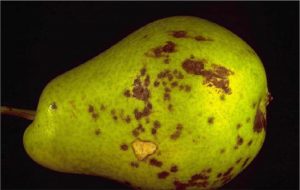
Figure 3. Pear scab. Photo: Howard F. Schwartz, Colorado State University
Pear scab (Venturia pirina) (Figure 3), a fungal disease closely related to apple scab, is neither as common nor as economically important on pears as apple scab is on apples. Nevertheless, it can cause economic damage by marring the appearance of the fruit. Pear scab causes lesions on leaves, shoots, and fruit, and—unlike apple scab—infects twigs, where it can overwinter. Pear cultivars differ in their susceptibility to scab. Organic control is identical to that for apple scab (Jones and Sutton, 1996), usually consisting of treatment with sulfur, lime sulfur, or Bordeaux mixture. See ATTRA’s Apples: Organic Production Guide for details, including the use of the Mills Table to predict infection periods.
Pear Decline
Historically, pear decline was a devastating disease. Accidentally brought to the United States from Europe in the 1940s, pear decline was responsible for the deaths of well over a million trees in western commercial pear-growing districts in the 1950s and ’60s (Agrios, 1997).
The phytoplasma organism that causes pear decline is vectored by pear psyllae (see the section on Insect and Mite Pests), and full expression of the disease depends greatly on rootstock susceptibility. It can also be spread by grafting and budding with infected propagation wood. Infected trees usually exhibit a slow decline in vigor and fruit production, cupped leaves, and early fall defoliation. Interestingly, the phytoplasma does not appear to increase in infected trees but does increase in the psyllae; consequently, heavy and continuous feeding is most likely to result in symptoms, and, conversely, good pear-psylla control usually results in disease remission even when rootstocks are highly susceptible (Elkins et al., 2001).
With this understanding and subsequent conversion to resistant rootstocks, as well as better psylla control, pear decline is now itself in decline. Susceptible rootstocks include seedlings of P. serotina, P. ussuriensis, and P. calleryana. Tolerant or resistant rootstocks include the OH XF series, Bartlett seedling, and P. betulaefolia. Other control methods include keeping the tree in good vigor with proper weed control, water management, and fertilization.
Other Diseases
Two foliar diseases, fabraea leaf spot (Fabraea maculata) and mycosphaerella leaf spot (Mycosphaerella pyri), are usually no problem in sprayed orchards but can reach damaging levels in unsprayed ones (Jones and Sutton, 1996). Susceptible cultivars, which include nearly all European pears, can be defoliated, resulting in reduced buds and dwarfed or—if the fruit itself is infected—unmarketable fruit. Sprays for pear scab, such as Bordeaux mixture, will generally control these two maladies as well. Also, Surround™, a kaolin-clay-based insect repellant, is registered and labeled for suppression of fabraea leaf spot.
The Rootstock Connection
Choice of pear rootstock can be important in controlling fire blight as well as for factors such as tree size, soil adaptability, tolerance to pear decline, and cold hardiness. For decades, almost all pear varieties were grafted onto ‘Bartlett’ seedlings, probably because ‘Bartlett’ seeds were so easily obtained from the pear canning industry. Just about the only other rootstock choice for years was quince, which resulted in a dwarfed tree that often struggled to survive and also exhibited graft incompatibility with many cultivars. ‘Bartlett’ seedling rootstock produced a large tree, was not adapted to all soil types, and was subject to fire-blight infection and pear decline, a disease that was a problem in many western production areas. ‘Bartlett’ was not the ideal rootstock that the pear industry desired.
In 1915, Oregon researcher Dr. F.C. Reimer began a long-term rootstock search and breeding effort that started to address these problems and is still producing results. He went to China and brought back seeds of several Pyrus species. He also crossed a European-type cultivar, Old Home, with a chance seedling which he dubbed Farmingdale, both of which exhibited resistance to fireblight, and the selected progeny of which are now referred to as the OH X F rootstocks. Washington State University and Oregon State University research, as well as grower experience, continue to add to our knowledge of pear rootstocks.
Several of these OH X F clonal (reproduced asexually as opposed to sexually reproduced seedlings) rootstocks have emerged as dependable and many more as promising. Tree size control, as well as regional differences in soils, climate, and disease incidence can now be addressed, somewhat, with different rootstocks. The commercial pear industry centered in the Pacific Northwest appears to be best served by the semi-dwarfing OH X F 40, 69, and 87, with 87 showing consistently best results in grower trials.
Among the seedling rootstocks, P. calleryana has proven to be a very good fire-blight-resistant seedling rootstock for the South and upper South. It can tolerate wet soils, drought, acid soils, and even clay soils. It is, however, not very cold hardy and produces a large tree.
P. betulaefolia is another rootstock that has specific desirable qualities: tolerant of wet and droughty soils, very resistant to pear decline, and cold hardy. Like virtually all seedlings other than the size-controlling clonal rootstocks, it produces a large tree. “Betch,” as growers often call it, seems particularly good for Asian pears. Jeff Boullioun (see “Grower Profile”), commercial-scale, organic Asian-pear grower in Washington, found that Asians on OH X F rootstocks were too susceptible to the ravages of pseudomonas and replaced them all with “betch,” which continues to give him good production. Through pruning and training he is able to keep his Asians on “betch” to about 12 to 13 feet in height.
Bartlett seedling is still widely used and has some desirable qualities like drought tolerance. Nevertheless, if Bartlett is used as an understock, the grower should be aware that a fire-blight infection could occur. This problem can be mitigated by grafting to a fire-blight-resistant cultivar, but if the rootstock is allowed to sucker, those tender shoots can be infected and the infection spread to the roots.
Insect and Mite Pests
Many of the same pests that affect apples also prey on pears, although usually to a lesser degree, with codling moth being a good example. More information on dealing with these pests can be found in ATTRA’s Apples: Organic Production Guide. Some of the pests that particularly affect pears are discussed below. Proper pest identification and orchard scouting are key to implementing successful IPM programs. ATTRA’s Biointensive Integrated Pest Management (IPM) publication provides additional information.
Pear Psylla
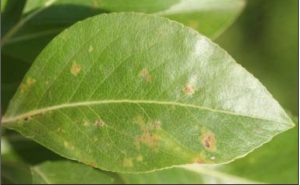
Figure 4. Damage from pear psylla. Photo: Whitney Cranshaw, Colorado State University
The pear psylla (Cacopsylla pyricola), an aphid-like insect whose only host is the pear, is the crop’s most significant insect pest. In conjunction with fire blight, pear psylla is largely responsible for declining eastern pear production. The honeydew left by the psylla damages the fruit by supporting growth of sooty mold and causing a black russeting; these two effects account for most of the economic damage caused by the psylla. It is also an important vector of fire blight and pear decline disease, and can weaken trees in areas of heavy infection.
Although the psylla develops resistance to insecticides, it can usually be controlled either with dormant oil sprays or with sulfur sprays (but not a combination of the two, which damages plants). Insecticidal soap can reduce active populations during the growing season. Fortunately, the recently introduced Surround™ kaolin-clay-based insect repellant is effective against pear psylla. In fact, use of Surround for pear psylla control has made organic pear production viable for the first time in states like Michigan (Anon., 2002). The psylla also has a number of natural enemies such as predatory flies, minute pirate bugs, and lacewing larvae. In organic orchards parasites and predators can help control psylla below economically damaging levels, especially when combined with a program of oil treatments (Elkins et al., 2001).
True Bugs
Stink bugs, tarnished plant bug, and other true bugs (insects in the order Hemiptera) will readily feed on pears throughout the growing season. Early feeding damage may result in a pucker or dimple in the fruit. Mid- and late-season feeding often results in the development of so-called “stone cells” immediately beneath the feeding site. These stone cells are very hard and can seriously compromise the marketability of affected fruit.
Some fruit and nut growers reduce true-bug damage by maintaining unmown leguminous trap crops (clovers, vetches, peas, etc.) near the orchard (Anon., 1999). Unmown areas and cover crops can also serve as habitat for predator insects; for more information; see the ATTRA publication Farmscaping to Enhance Biological Control.
Surround™ is labeled for suppression of stinkbugs and lygus bugs in pears. Also, some of the botanical insecticides derived from the seeds of the neem tree are effective against true bugs on fruit crops. For example, OMRI-approved Aza-Direct™ is labeled for use on all pome fruits for the control of weevils, thrips, true bugs, leafhoppers, aphids, leafrollers, cutworms, flies, and mites.
Mites
In high enough numbers, pearleaf blister mites (Phytoptus pyri) and pear rust mites (Epitrimerus pyri) can reduce the photosynthetic efficiency of leaves and cause russeting on fruit. Both species will likely be more troublesome in dusty conditions, as the dust interferes with their natural predators. These predators—including green lacewings, predatory mites, and various species of ladybird beetles, as well as bigeyed bugs, minute pirate bugs, and predatory thrips—will usually control mite outbreaks if the predators are not disrupted by dust or pesticides. Orchard monitoring can help establish whether adequate numbers of beneficial insects are present. If they are not, horticultural oils sprayed during the dormant season can suppress mite eggs through suffocation. Neither horticultural oils nor other materials approved for organic production provide economic control of damaging populations.
Another pest that contributes to poor yields and smaller fruit is the spider mite. Dormant horticultural oils and insecticidal soaps can both help control spider mite outbreaks. Neem-based biological insecticides are also labeled for controlling mites on pears. European-pear cultivars are more sensitive to mite feeding than Asian pears, and any pear that is drought-stressed will be more susceptible to mite damage (University of California Statewide Integrated Pest Management Project, 1991).
Other Insects
Other insect pests that may affect pears include codling moth, apple maggot, scale, and plum curculio. These insects are covered in ATTRA’s Apples: Organic Production Guide publication. The pear slug (actually a sawfly larva) causes leaf damage; it can be controlled with a forceful stream of water, soap, or wood ashes. The leafroller complex—including tufted apple bud moth, variegated leafroller, and redbanded leafrollers—represents another potential, but comparatively minor, pear pest problem. Mating disruption tools that are effective for some leafrollers are being developed. In addition, there are biological insecticides labeled for control of leafhoppers, aphids, and leafrollers, among other pests.
Grower Profile:
Peshastin Creek Growers Association
(Excerpted by permission from Renewing the Countryside: Washington, by Ingrid Dankmeyer , John Harrington, and Jim Anderson, published in 2005 by Sustainable Northwest, 813 SW Alder Street, Suite 500, Portland, OR 97205)
Central Washington’s Wenatchee Valley is an excellent place to grow pears and apples, with warm, dry days and cool nights. Around Peshastin Creek, a tributary of the Wenatchee River, a handful of family orchardists are carrying on the work started by their grandfathers and great-grandfathers. But this generation of pear growers is experimenting with gentler pest management strategies — strategies that seem to be working.
In 2000, Dr. John Dunley, Washington State University tree fruit entomologist, set out to build on the codling moth mating disruption success story (see ATTRA’s Apples: Organic Production Guide for more information on codling moth mating disruption). He wanted to complement the mating disruption approach with strategies to increase the populations of beneficial insects that eat codling moths and other pests.
John explains, “A lot of the natural enemies — or good bugs — come from the surrounding natural vegetation, so if everyone went to a soft (low pesticide) program, we could create avenues for movement of natural enemies over an entire area without any pesticide barriers.” When high levels of pesticides are used, both the bad and the good bugs are killed. John was still developing his idea when the Peshastin Creek Growers Association got wind of it. Says John, “I was going to take another year to further develop the theory and the economics of it when these guys heard about it and gave me a call.”
In the beginning there was a lot of concern about whether or not there would be economic damage in the orchards due to pests coming in and harming crops to the extent that they couldn’t be sold. Peshastin Creek grower Dennis Nicholson says, “In some situations that did happen because people were not on top of things. That has been part of the learning curve: you have to farm a little differently in a soft pesticide program than you do in a conventional program.”
Now half of the 310 acres managed by the Peshastin Creek Growers is organic and the rest is managed with a soft program. Says Dennis, “It’s gotten to the point where the soft program is very effective. The spray I am currently using for the soft block is exactly the same spray as I am using for the organic blocks. The only significant difference between the organic and the soft block is that we are able to use herbicides, rodenticides, and fertilizers.”
The Peshastin Creek Growers market collectively under the “Gently Grown” label and received the Food Alliance sustainable agriculture seal of approval in 2002. Finding markets for their unique product that is not quite organic and not conventional has been a bit of a challenge. Says Nicholson, “Last year for the first time we found a customer in California who was willing to pay us a premium for the Gently Grown label, so there are niches out there that are willing to pay for a pesticide-free or low-pesticide fruit.”
“One of the things that might be different about our group is that we all started out as conventional farmers, and our fathers were conventional farmers,” adds Dennis. “We had to come into the idea of a soft pesticide or organic program from our fear of insect resistance, our fear of polluting water, our fear of regulation, plus our motivation to raise a superior product and do it in a kinder, gentler way. That’s where the Gently Grown label comes from; we are trying a more ‘gentle with nature’ approach to growing our product, and basing our inputs on need.”
Asian Pears

Chojuro Asian pear. Photo: Jerry A. Payne, USDA Agricultural Research Service
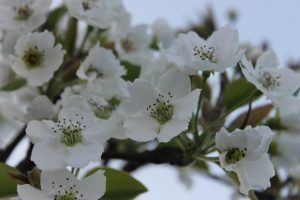
Figure 5. Heavy bloom on Shinko pear will require blossom or fruit thinning to prevent the tree from over-cropping and to maintain fruit size and quality. Photo: Guy Ames, NCAT
Because they are relatively new to much of the United States, Asian pears deserve some additional comment. A crisp, juicy fruit, Asian pears are also known as Oriental pears, nashi, sand pears, apple pears, or salad pears. The more than 1,000 varieties of Asian pear range widely in shape, color, and taste. Only about a dozen varieties are commonly grown in U.S. commercial orchards.
Asian pears are slightly less cold-hardy than European types; they may suffer tissue damage at temperatures below -10°F but are generally hardy to -20°F, making them best adapted to USDA plant hardiness zones 5-9. Most Asian pears bloom slightly earlier than their European counterparts and may lose some blooms or buds to freezing in areas with a highly variable spring climate.
Culture of Asian pears is similar to that of European types, but not identical. One significant difference is the common tendency for many of the Asian types to set too heavy a fruit crop, which requires hand thinning of young fruit soon after bloom. Shinko, a popular cultivar because of its high fruit quality and fire blight resistance, is especially prone to this problem (Figure 5). If not properly thinned, Shinko and any other heavy-bearing Asian-pear cultivars will not be able to mature such a load successfully. Fruit size and quality will suffer. On the other hand, thinning to promote fruit size may result in reduced yield per acre compared to European-pear varieties.
Another difference between Asian and European pears is that Asian pears ripen on the tree—they do not have to be picked and then cured like European pears. This is an advantage for most growers, especially growers who are retailing direct to consumers. The fruit can be tree ripened and is ready to eat when picked or can be held in cold storage. Growers do not have to educate buyers about curing, as they might with European pears.
It is important to note that the delicate fruit of many Asian-pear varieties must be carefully handled during and after harvest to minimize bruising, punctures, and roller marks. The skin of Asian pears discolors quickly following rough handling, making careful picking and packaging a necessity, and mechanical handling risky. To prevent damage to Asian pears, it may be best to pack them into padded boxes or trays in the field where they are picked.
More information on Asian pears can be found in the sources provided in the References and Further Resources sections.
Grower Profile:
Organic Asian Pear Growers Jeff and Kristine Boullioun
Though Busy Bee Orchard co-owner Jeff Boullioun still has 20 acres of apples and 26 acres of Bosc and Super Red European pears, it’s the 9 acres of organically certified Asian pears of which he seems the proudest. When other early adopters were giving up on Asian varieties, Boullioun had figured out that each variety had to be treated according to its individual traits. “Each Asian pear is grown differently and handled differently,” Boullioun said. “That’s our distinct advantage over other Asian pear producers.”
Busy Bee Orchard’s Asian pear packing line. Note the “socks” on the individual fruit, reflecting the Boulliouns’ concern for fruit quality. Photo: Jeff Boullioun
Boullioun said the special treatment starts long before harvest. Each Asian pear tree is marked with colored paint to make sure workers at Busy Bee Orchards know the difference between the 11 varieties. Special pruning practices are used both for winter and summer pruning, because some varieties need heavy trimming while others need less. The same concept applies to thinning of the fruit, and, of course, each variety has its own window for optimum quality at harvest.
The Boulliouns bought 58 acres near Oroville, Washington (near the Canadian border), in 1981 and planted it all to Red and Golden Delicious apples. Generally poor prices for apples prompted a gradual transition to pears, beginning in 1987. Busy Bee Orchard became organically certified in 1999 “primarily for economic reasons. But after growing organically for over 10 years now, we hope that we don’t ever have to farm conventionally again. Our workers like the fact that we don’t spray anything harmful to them and re-entry on most sprays is only a few hours. We only target the pest and save the beneficials.”
“There are so many great organic pesticides out now that we don’t have much of a problem with insects. The worst problem is weed control, as there aren’t any really effective organic herbicides. We do a lot of hand weeding around the young trees, use a string trimmer around the older trees and rotovate. Birds can also be a real problem when the fruit ripens. We use pretty much every repellent available: cannons, squawkers, balloons, noise guns, flash tape, GO. The birds especially love the Asian [pears], and we can lose hundreds of dollars a day to bird pecks.”
Pseudomonas is their most serious disease problem. Switching to P. betulaefolia rootstocks helped, but their main control technique is copper sprays at early and full bloom.
They market their organically certified pears through Stemilt brokers, and the bulk of their crop ends up in Whole Foods Market stores. Says Jeff proudly, “We’re very particular about what goes in the box, especially since that box has our name on it.”
Economics and Marketing
According to USDA’s 2008 Organic Production Survey, the United States had 257 certified organic farms that produced 21,684 tons of pears worth $16 million. (Geisler, 2011).
At one time pears were grown commercially on a large scale throughout the United States. However, because of the prevalence of fire blight in the humid eastern and southern states, most pear production has been relocated to the drier areas of the Pacific Northwest. According to the USDA, 97% of the pears produced in the U.S. are grown in Washington, Oregon, and Northern California (Foreign Agricultural Service, 2002).
In general, pear prices tend to fluctuate based on crop size—which can be highly variable on account of weather and fruit set rates—and on the number of growers producing pears in a given year. Fluctuation in the organic market is also based on these factors, and the premium that organic growers can expect to receive for their product is unpredictable at best.

Conference pear. Photo: Courtesy USDA/ARS
The market for pears is weaker than it could be, largely because of consumers’ unfamiliarity with the different types of pears and how to use them. One survey showed that Bartletts and winter pears were consumed by no more than half of America’s households, and then only occasionally (Pear Bureau Northwest, 2012). A market study funded by the Pear Bureau showed that only 3 out of 10 people have tried d’Anjou pears, and 2 out of 10 have tried Boscs. One of the obstacles limiting pear consumption is that many consumers do not know how to ripen them. Providing information on ripening may help increase sales (though the Pear Bureau study also found that most people preferred to buy pears already ripened). Many pear purchases are impulse buys, so appearance is critical. Rough handling causes brown marks on the skin that may not appear until the fruit has begun to ripen, and these will decrease customer appeal, so pears should be handled gently.
The market for Asian pears is mixed. Until 1995 or so, the wholesale market for Asian pears was quite open and prices were high, particularly on the West Coast and in cities with large Asian-American populations. But Asian pears have been heavily planted in California for more than 20 years, and those orchards are now mature and bearing, more than meeting local demand and causing price drops in some areas. Additionally, China has become the world export leader for pears, producing 15 million tons in 2010, and depressing wholesale market prices for domestic producers (Foreign Agricultural Service, 2011).
On the other hand, outside of California, Asian-pear growers who direct-market to a retail clientele—especially a local Asian-American population—report brisk sales and good prices from locations across the country. Offering taste sampling of fruit, where practical and allowed by local health regulations, is probably a good idea for building markets, since so many Americans are still unfamiliar with Asian pears.
Asian pears are breaking out of their niche to join the mainstream market, and may represent an opportunity for producers as market awareness and demand continue to grow.
Postscript: Pears in the Humid South—The Author’s Experience
Figure 6a. A new blight-free shoot resulting from budding blight-resistant cultivar Niitaka onto a healthy root sprout. The original tree, stump remaining, was killed to the ground by fire blight. The P. calleryana roots are highly blight-resistant. Photo: Guy Ames, NCAT
I have been a lousy pear orchardist, but I think and hope that my faults might benefit others. In 1990-1992, I planted 120 pear trees as an adjunct enterprise to my larger apple orchard. I planted a lot of cultivars, both European and Asian, all with some claim to fire-blight resistance, on several different rootstocks in a slightly acid, well-drained sandy loam soil with a red clay subsoil.
Fire blight soon became my teacher and Darwinian judge of the weak. I learned firsthand that the resistance ratings generated from research in California or New England meant very little in the South, where the intense heat and humidity skewed the environment to the favor of Erwinia amylovora (see the Appendix on the Disease Triangle for more details). I probably lost 25% or more of my trees in the first three to four years. And I never sprayed antibiotics; my only control efforts were aimed at cutting out strikes (infected wood) during dormancy.
Still, I had lots of fruit from Magness, Maxine, Shinko, Korean Giant, and a smattering of a few other varieties, and what pears I took to the Fayetteville Farmers Market sold easily and quickly. The Asian pears, especially, were cosmetically near-perfect and very easy to sell.
More importantly, compared to the apples and excluding fire blight, the pears had practically no pest problems at all: no trunk borers, no codling moth, no plum curculio, no summer rots, and no sooty blotch. All these were serious problems in the apples, and I have to wonder if some—especially the codling moth—would have been more of a problem if the apples hadn’t been so close to possibly lure them away from the pears. Other than fire blight, the only significant pest problem I’ve had on pears has been dimples on the fruit from early-season feeding by tarnished plant bugs and stink bugs.
Figure 6b. Close-up of the bud described in Figure 6a. killed to the ground by fire blight. The P. calleryana roots are highly blight-resistant. Photo: Guy Ames, NCAT
In 2000, I essentially abandoned the pear orchard. I did not prune. I did not water. Once or twice a year I’d run my riding lawnmower through it. I let my neighbors run their sheep in it. Fire blight continued its lessons: Chojuro, which at first seemed resistant, began to succumb to the disease in a series of years with long, wet springs, and Shin-Li (one of my early favorites for its ginger-vanilla flavor) was totally wiped out. Also, in the decade 2000-2010, the weaker rootstocks were pretty much eliminated by virtue of my neglect.
So, what’s left after 10 years of neglect, heat, humidity, disease, ice storm, drought, and flood? The rootstock that survived best was Pyrus calleryana (the species from which the now-notorious ‘Bradford’ ornamental pear comes from). The surviving Asian and European cultivars (roughly in order of their health and productivity): Shinko, Niitaka, Korean Giant, Maxine, Magness, Clear Moon, and Koyama. Surviving but poor in either quality, yield, or disease resistance were: Kieffer, Warren, Seckel, Chojuro, Harrow Delight, Moonglow, Harvest Queen, Potomac, and Bartlett seedlings as rootstocks. Total losers for me: OH X F 333 rootstock, and three Asian types with great flavor, but too susceptible to fire blight–Shin-Li, Hosui, and Shinseiki. One other, Erishinge, I couldn’t even get to live long enough to fruit!
In several instances where fire blight killed the cultivar, the P. calleryana roots survived and sent up vigorous, blight-free shoots. Now that I have resumed care of the pears, I have budded some of these shoots to blight-resistant cultivars (see Figures 6a and 6b). In this case, I left the blighted stump to dramatize the relative resistance and susceptibility of the cultivars and root. With the roots already established, by the end of the growing season the tree will probably be five to six feet tall and branched.
I lay no claim to the scientific method in these comments. I did not try to replicate my experiences (please, no!), and “treatment” sizes were small (i.e, three of one variety, four of another). And, hopefully, my conditions—poor soil, southern climate, and neglect—will not be yours. These are just my observations. Make of them what you will. May my losses be your gains!
Appendix: Fire Blight, Disease Resistance, and the Disease Triangle
The occurrence of disease—any disease on any plant or animal—is dependent on three factors: 1) a susceptible host, 2) the presence of the disease-causing pathogen, and 3) a suitable environment for infection and disease development (the “disease triangle;” see Figure 1). This fact is very important to understanding fire blight incidence in pear orchards, especially in terms of managing this potentially devastating disease in different parts of the country.
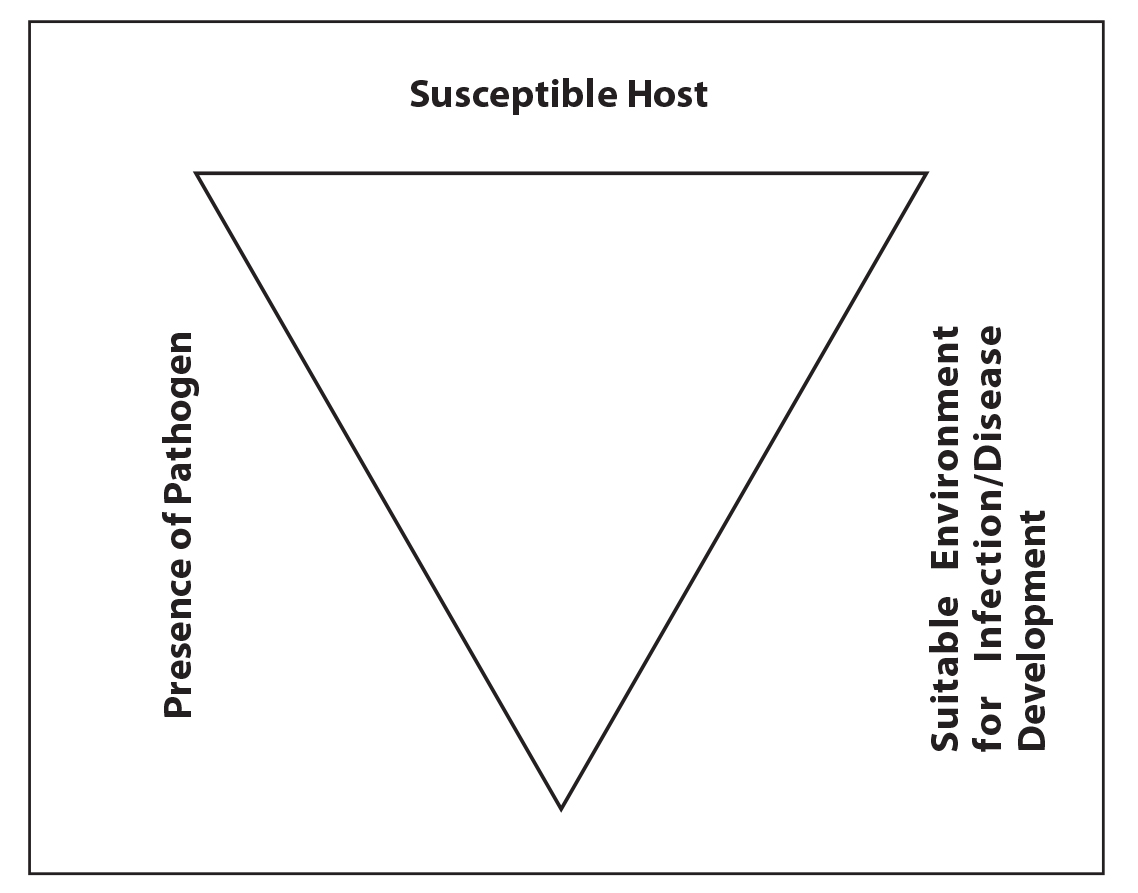
Figure 1. The Disease Triangle.
Let’s start at the top of the triangle with a corollary to point 1: heritable disease resistance is rarely absolute. When a plant breeder or plant pathologist refers to a pear cultivar as “fire blight resistant,” he or she is speaking in relative terms. Usually we read or hear something like “somewhat resistant,” “very resistant,” “moderately resistant,” or “slightly susceptible,” To further complicate matters, different researchers use different rating scales to describe resistance/susceptibility—there is no agreed-upon standard. For example, some published studies rely on a “1 to 10” scale, which is usually based on a visual estimate of damage, while others may use more absolute measurements, such as the centimeters of shoot tissue affected by fire blight.
Regardless of the failings of the various rating systems, the phenomenon of differential resistance/susceptibility is real—pear cultivars vary greatly in their reaction to the presence of Erwinia amylovora. Some cultivars, such as Magness and Shinko, will only rarely suffer any fire blight strikes, and, if they do, the blight will rarely intrude into any wood older than one year. In contrast, when all three factors of the disease triangle conspire, fire blight can sometimes kill even mature trees of susceptible European cultivars in a single year.
The second face of the triangle—presence of the pathogen—is the one that seems to prompt most of our efforts as growers. When we spray copper, Blight Ban™, or one of the antibiotics, we are trying to reduce or exclude (in the case of Blight Ban) the pathogen from potential infection sites. There is also a geographic component to this part of the triangle, as E. amylovora is much less prevalent in some parts of the world than in others.
The third face of the triangle—an environment conducive to the disease—is also related to geography, mostly by climate. Where the climate is warm and wet, especially in the spring, fire blight infection and development are favored. The more arid parts of the western United States are not nearly as prone to fire blight problems as most of the East. But these large climatic and geographic features are not the only components of a disease-promoting or disease-suppressive environment—the orchardist can manipulate parts of the orchard micro-environment to help suppress disease development. For example, reducing fertilization can limit fast-growing succulent tissue, which is especially prone to infection and seems to provide the disease its fastest entry into the wood.
Another practice that can be adjusted to alter the orchard environment is pruning, which can “open up” a tree to allow more-rapid drying of plant tissues and thus prevent disease. However, a grower in a different situation might need to reduce pruning in order to avoid fostering the lush shoot growth (which is more susceptible to fire blight) that usually follows heavy pruning.
There is considerable interplay, of course, between the faces of the disease triangle. It is especially important to understand that given high levels of inoculum and the proper environmental conditions, medium levels of varietal resistance can be overcome. For example, Shin-Li—released by the University of California as “fire blight resistant”—is relatively resistant in the climate of California, but can suffer severe fire blight infection in the Southeast if not adequately protected by spraying. If you plant Bartlett in South Carolina, for another example, and don’t spray, you can watch the disease triangle imitate the Bermuda Triangle, as your trees disappear one-by-one and year-by-year.
Note: The mention of specific brand names, companies, or manufacturers is for educational purposes only and does not constitute endorsement by NCAT, ATTRA, or USDA.
Pears: Organic Production
By Guy K. Ames and Holly Born, NCAT Agriculture Specialists
Published 2003
Revised June 2019 by Guy K. Ames
NCAT Agriculture Specialist
© NCAT
IP167
Slot 36
Version 102419
This publication is produced by the National Center for Appropriate Technology through the ATTRA Sustainable Agriculture program, under a cooperative agreement with USDA Rural Development.


